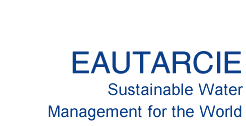
The considerations developed herein are only valid for those who adopt the PLUVALOR system. This choice is a personal, rational and reasoned decision that should strictly remain a private concern. Before purchasing a system, also read the page on how to deal with a rainwater harvesting equipment supplier.
The text within this page was first published on www.eautarcie.com: in 2003
The original text has been adapted and translated in English by André Leguerrier and was first published on this page at www.eautarcie.org: 2009-10-01
Last update: 2017-04-23


Filtering Rainwater
Producing innocuous domestic water for non-food uses
Based on the experience of those households that have chosen the PLUVALOR system, « innocuous » hygienic water for non-food purposes is obtained by installing a filter with 10-micron porosity![]() . This filter must be placed downstream from the well pump system.
. This filter must be placed downstream from the well pump system.
It sometimes happens that cistern water contains particles that convey a slight turbidity to the water. These are fine particles that come from dust, micelles (bacterial clusters) and plant residues (leaves, moss). To protect the 10-micron filter, a primary sediment filter with a porosity of 25 to 50 microns![]() should be placed before it, right after the pump system. When selecting a sediment filter, choose one with a washable (and reusable) filter such as a nylon mesh, instead of dispensable cartridges.
should be placed before it, right after the pump system. When selecting a sediment filter, choose one with a washable (and reusable) filter such as a nylon mesh, instead of dispensable cartridges.
Producing biocompatible drinking water
In the world's most luxurious hotels, you can drink bottled Tasmanian rainwater. Wholesale, a 12-bottle case of 750 ml bottles will only cost you 60 dollars US! This water is considered tops, in terms of water quality (free advertising!).
You can obtain the same quality rainwater from your cistern by microfiltration or by reverse osmosis, for a cost respectively of 0,04 € or 0,08 € per litre (2011), when considering the amortization of your filtration set-up. (The system described below also eliminates all atmospheric-sourced contaminants.) And let's not forget that purchasing water that has been shipped by airfreight from the other side of the world is totally incompatible with sustainable development or CO2 emissions' reduction!
With a PLUVALOR system, there will be only one or two potable water taps in the home. These faucets are to be located in the kitchen, in a guestroom, or eventually in the bathroom. This last solution is not altogether necessary, since for brushing one's teeth, « innocuous water » is quite satisfactory (i.e. water that goes through a 10-micron filter, as described at the Implementing the PLUVALOR System page). The tap will be a distinctive gooseneck shaped faucet with lever handles, which is usually supplied with drinking water filtration systems.
Two options exist to make cistern rainwater potable (better still, to make rainwater biocompatible): microfiltration or reverse osmosis. The choice between the two techniques is mainly a question of cost/budget. In some instances, it can also be a question of filtration efficiency.
Microfiltration (MF)
Microfiltration includes three filtration levels: a 5-micron primary filter, a 1-micron ceramic filter![]() [1] and an activated carbon filter. The last two filters are often combined in the same cartridge.
[1] and an activated carbon filter. The last two filters are often combined in the same cartridge.
Microfiltration with polymer membranes is also acceptable, as long as the 1-micron maximum porosity is respected. My preference for ceramic cartridges (like those manufactured by Aquasain and Doulton) is due to the lesser environmental impact of their disposal. Crushed ceramic is perfectly adapted in nature as a soil component. That is not the case of membrane polymers, which can take centuries to degrade.
For microfiltration, make sure to install a water meter on your plumbing system, upstream from the water pump system. The filtering capacity of the ceramic filter cartridge is determined by the manufacturer. With chlorine-free rainwater, this capacity is about 20 000 to 25 000 litres. Beyond this, the filter element has best be replaced.
In the course of water analyses that we performed on various user installations, water quality readings always complied with the strictest standards, even in older set-ups that hadn't had recent maintenance.
Here are indications of how a good system works:
Due to its low permeability, ceramic water filtration reduces water pressure at the faucet. Filling a 200 ml (6 to 7 oz) glass can easily take 20 to 30 seconds. When it takes longer, it's time to clean the ceramic candle. This is done under running water ("innocuous" domestic water), at the kitchen sink's cold-water tap, with a bristle brush specifically designated for this purpose. Then, care must be taken to screw the filter element back in place without excessive force. After that, if the water pressure is unusually high (compared to that of a newly installed cartridge), this can mean that the cartridge has not been screwed back on properly: water goes through without being filtered. It also sometimes happens that while cleaning or manipulating the cartridge, the ceramic is accidentally cracked. Such cracks will also let water flow through without adequate filtering: the cartridge must then be replaced. It is wise to keep a spare cartridge on hand for such incidents.
When the activated carbon block [2] contained in the ceramic candle becomes prematurely saturated, this can mean that the water feed is contaminated with hydrocarbons, pesticides or other organic impurities. Fortunately, this is easily detected as the water quickly takes on an objectionable taste. When an activated carbon filter is saturated, it discharges part of its contaminant load back into the water (thus altering its taste), a clear sign that the filter must be replaced.
Considering normal daily water consumption of about a dozen litres, the primary filter will need to be replaced annually whereas the ceramic filter can last 4 to 5 years.
Fabulous activated carbon holds back almost all organic compounds, odours and taste. Yet, when drinking water, a person's organoleptic faculties constitute a means of detection that most often exceeds the sensitivity of the most sophisticated analytical instruments available. An important detail: our sense of smell and taste can only work perfectly when in the absence of chlorine. Chlorine effectively masks odours from organic pollutants, including endotoxins issued by pathogenic bacteria – killed by chlorine. This is the fundamental reason that people who use the PLUVALOR system eventually detect incredibly weak quantities of various pollutants. PLUVALOR users therefore become very demanding on water quality. As soon as activated carbon filters become saturated, an unpleasant « cistern taste » is quickly detected.
Reverse osmosis (RO)
In a reverse osmosis system, the same 5-micron primary filter described above is used, but the ceramic filter is replaced with a synthetic membrane system having such a low permeance that it even intercepts bacteria, viruses, micropollutants, and most minerals dissolved in water.
When you only have city water for your domestic water needs, and you want to obtain drinking water that is biocompatible, reverse osmosis is your only choice. In contrast, those with a rainwater harvesting system have the choice between reverse osmosis and microfiltration. Presently (2011), you can find reverse osmosis units that are designated for domestic aquariums, a less expensive solution, as long as you accept not having a pressure tank to maintain a stable water pressure. A pressure tank system remains however more convenient. In light of city water's high mineral content, reverse osmosis will deliver water having similar characteristics to a cistern's reclaimed rainwater filtered by microfiltration.
When starting with rainwater, this technique produces water with very little mineral salt content. This is about 10 to 20 mg/l (milligrams per litre), which is the lowest limit for biocompatible water. Below this limit, it is best to add a few milligrams of raw sea salt or a tablespoon of fresh lemon juice per litre of water. Lemon juice contains ascorbic acid, which will lower the water's rH2 value. This is conducive to obtaining biocompatible water. When the water's conductivity falls below 10 µS/cm or its resistivity increases over 100.000 ohm•cm, it is best to add a tablespoon of fresh lemon juice per litre of filtered water.
How to purchase a RO Unit
Some ceramic filter systems found on the market include Aquasain and Doulton. Usually, individual components of such systems can be purchased separately. Before buying, it is wise to shop and compare.
The choice of a unit should be based on objective criteria. The membrane, which is the essence of the filtering element, is produced worldwide by one or two manufacturers. Almost all units on the market use the same manufacturer's membrane. Therefore, one can reasonably assume that a less expensive unit will deliver the same quality water as a more expensive unit. The difference will be in the unit's configuration, it's ease of use, or the membrane's rinse operation.
Some dealers propose expensive systems, as high as 1.000 €. They justify this price by including in their system additional treatment systems downstream from the reverse osmosis unit in order to produce chemically pure water. These useless items include:
- resin-type filters that remove mineral salts that may have gotten through the reverse osmosis membrane;
- cartridges to remineralise the water (avoid these, as they reduce the filtered water’s quality);
- UV lamps to sterilize the water (also to be avoided).
Chemically pure water is obviously not biocompatible, nor is it even potable.
Personally, I don't agree with this practice, which consists in removing everything from the water and than putting back minerals similar to what was removed. This raises the water's unit cost and weighs more heavily on the environment. Such systems are found in North-America where you can also find 4-gallon (18-litre) bottled water dispensers that provide treated water that has been un-ecologically demineralised and re-mineralised; these dispensers even chill or heat the water on demand (an additional un-ecological energy expense).
Any treatment proposed beyond reverse osmosis is unnecessary and a waste of excess material and equipment. A simple reverse osmosis unit, with a 5-micron primary filter, a membrane and an activated carbon block filter is perfectly adequate for rainwater filtration as it delivers high quality water. In the filtering process, water flow is mainly affected when the primary filter becomes clogged. This filter is usually changed once a year. A reverse osmosis unit’s membrane will last at least 6 to 8 years when filtering rainwater. With city water, the membrane’s lifespan is reduced to less than 3 years. Thus, with city water, it will be wise to protect your osmosis membrane from chlorine damage by placing an additional activated carbon « pre-filter » (i.e. another primary filter) upstream from the membrane or the 5-micron primary filter.
You also have the choice between a simple aquarium that delivers water drip by drip within a holding dispenser of a few litres capacity (that could overflow), or with a more expensive pressure tank system. The first solution has the advantage of guaranteeing always freshly filtered water. The second is easier to operate: no overflow possible, and water always available at the faucet. The down side is that a biofilm can eventually develop in the tank. This bio-film obviously raises the number of (absolutely harmless) bacteria in the filtered water.
A reverse osmosis unit that provides perfect water should not cost more than 300 €. If you include an extended warranty and after sales service program, the cost could go as high as 500 €.
Here's good advice: be sure to purchase a portable digital conductance![]() meter so that you can determine the exact moment the membrane needs to be replaced (not too early, nor too late). These can be purchased for less than 60€ (2011) from dealers in aquariums, swimming pools and also reverse osmosis units.
meter so that you can determine the exact moment the membrane needs to be replaced (not too early, nor too late). These can be purchased for less than 60€ (2011) from dealers in aquariums, swimming pools and also reverse osmosis units.
| Comparing Micro-filtration to Reverse Osmosis |
||
| Microfiltration (MF) | Reverse Osmosis (RO) | |
| Applications | For rainwater filtration. For filtering well water or spring water that are chemically adequate, but in which the bacteria content may be too high. MF's utility for mains city water is dubious as it does not modify the water's chemical composition, which are inherently un-biocompatible |
For rainwater filtration. RO is absolutely necessary when you want biocompatible water from river water, spring water or mains city water. |
| Microbiological quality | Beyond reproach | Beyond reproach |
| Physicochemical quality | MF does not modify the water's mineral content (Rainwater that is stored in a concrete/masonry cistern is perfect in this regard). | RO eliminates 85 to 99 % of mineral salts (depending on the salt's elemental size and electric charge), and also radioactive elements. When treating mains city water by RO, the delivered water quality is comparable to rainwater treated by MF. |
| Organoleptic (taste) quality | MF filtered rainwater still contains ± 50 mg/l of mineral salts. Its taste resembles that of weakly mineralised water. | RO filtered rainwater contains 10 to 20 mg/l of mineral salts, enough to qualify as biocompatible water. |
| Medicinal quality | Depurative, slightly diuretic | Depurative, slightly diuretic |
| Required maintenance | Wash the ceramic candle every 7 to 30 days, depending on cistern rainwater quality. Change the primary filter once a year. Change the ceramic cartridge after about 25 m³ of filtered water. |
Every 2 years, by the supplier, including the primary filter and carbon block filter replacement. The RO membrane must be changed every 3 to 8 years (3 years for mains water and 8 years for rainwater).. |
| Cost per litre (2008) | From 0,03 to 0,04 €/litre (2011) | From 0,01 to 0,15 €/litre depending on model chosen (2011) |
| Required well pump system | All systems adequate. | The pump system |
| Water loss | None: all the water that goes in comes out filtered. | For each litre of filtered water delivered, 2 to 3 litres are lost for backwash of the RO membrane. |
| Special components | None | Provide a pipe for return of backwash water to rainwater cistern. |
When commissioning a new cistern
As mentioned in the chapter on rainwater quality, when first commissioning a cistern, it so often happens that the first harvested rainwater has a pH close to 10. This also occurs after restoring cement coatings within the cistern (usually after 20 to 30 years use). Yet, when you want to produce drinking water, a microfiltration or reverse osmosis system must not be put into service until the pH goes below 8.5. Highly-alkaline water may disintegrate a microfiltration system's ceramic surface into dust. This dust will clog the filtering element and reduce water flow. (For other non-food uses, alkaline water is ok, which means that for the first few months, you will only be producing « innocuous » domestic water.)
To continue reading, go to PLUVALOR on the market page




